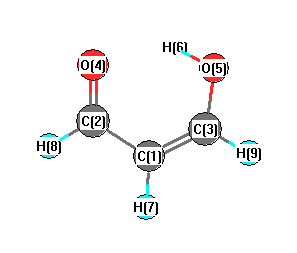Vibrational Frequencies calculated at QCISD(T)/6-31G*
| Mode Number |
Symmetry |
Frequency
(cm-1) |
Scaled Frequency
(cm-1) |
IR Intensities
(km mol-1) |
Raman Act
(Å4/u) |
Dep P |
Dep U |
|---|
| 1 |
A' |
3354 |
3217 |
|
|
|
|
| 2 |
A' |
3230 |
3098 |
|
|
|
|
| 3 |
A' |
3195 |
3065 |
|
|
|
|
| 4 |
A' |
3005 |
2883 |
|
|
|
|
| 5 |
A' |
1727 |
1657 |
|
|
|
|
| 6 |
A' |
1665 |
1597 |
|
|
|
|
| 7 |
A' |
1489 |
1429 |
|
|
|
|
| 8 |
A' |
1444 |
1385 |
|
|
|
|
| 9 |
A' |
1425 |
1367 |
|
|
|
|
| 10 |
A' |
1296 |
1243 |
|
|
|
|
| 11 |
A' |
1122 |
1077 |
|
|
|
|
| 12 |
A' |
995 |
955 |
|
|
|
|
| 13 |
A' |
891 |
855 |
|
|
|
|
| 14 |
A' |
503 |
483 |
|
|
|
|
| 15 |
A' |
292 |
280 |
|
|
|
|
| 16 |
A" |
1027 |
985 |
|
|
|
|
| 17 |
A" |
960 |
921 |
|
|
|
|
| 18 |
A" |
843 |
808 |
|
|
|
|
| 19 |
A" |
756 |
725 |
|
|
|
|
| 20 |
A" |
367 |
352 |
|
|
|
|
| 21 |
A" |
261 |
250 |
|
|
|
|
Unscaled Zero Point Vibrational Energy (zpe) 14923.4 cm
-1
Scaled (by 0.9593) Zero Point Vibrational Energy (zpe) 14316.0 cm
-1
See section
III.C.1 List or set vibrational scaling factors
to change the scale factors used here.
See section
III.C.2
Calculate a vibrational scaling factor for a given set of molecules
to determine the least squares best scaling factor.
